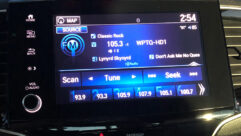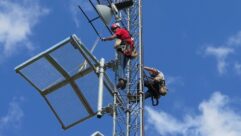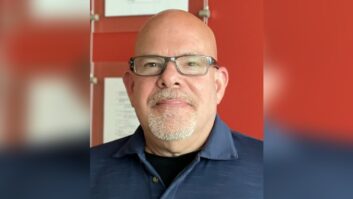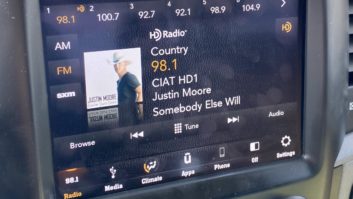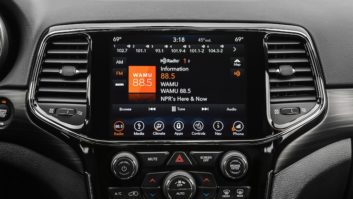WOR Has New York’s First Commercially Available HD Radio
More stations that have converted to HD Radio can hear their digital signals now that the first commercial receivers have arrived at facilities. Tom Ray, corporate director of engineering for Buckley Broadcasting/WOR(AM) in New York, has installed a radio in his vehicle and shares his impressions of the digital audio quality and coverage.
NEW YORK Santa arrived at the WOR studios a little early this year. As a matter of fact, he looked a lot like a FedEx guy. But in his bag, what wonders he carried! A Kenwood KDC-722 radio with Kenwood KTC-HR100 HD Radio tuner.
Since WOR installed an Ibiquity IBOC exciter and became New York’s first digital AM radio station on Oct. 11, 2002, we have had an Ibiquity reference receiver to listen to WOR-HD. That radio, however, is not conducive to portability. It weighs about 35 pounds. It is at least 30 x 17 x 7 inches. It runs on 120 volts AC. It would not fit in any dashboard I know of; and having to pull around a generator on a trailer hitch to power it didn’t excite me.
The Kenwood, however, did. I think I can safely say that I am the proud owner of the only commercial digital radio in New York, at least as I write.
This first-on-the-market HD Radio is part of Kenwood’s high-end system. If you are installing an aftermarket radio in your auto, not necessarily HD Radio-capable, you would be looking at Kenwood from among the many brands on the market.
Most of the Kenwood head units will accept Kenwood’s add-on Sirius tuner. You would be looking at spending a fair amount of cash if you were to go this route. As configured, the KDC-722 head unit retails for around $350. The HD Radio tuner retails for around $350.
Some cussing
The Kenwood radio head fit right into the dashboard of my 2003 Ford Explorer, with a little help from a $33 install kit from Crutchfield, which included a wiring harness that plugs right into the factory wiring in the dash. Marry it to the harness that comes with the KDC-722, and the system is pretty much plug-and-play.
Installing the HD Radio tuner part was a little bit of a challenge. The cabling that came with the tuner was more than adequate, with proper routing, to place it behind the first back seat. The HD Radio tuner, however, has a set of RCA jacks that I wanted access to so I can record audio samples while driving around.
After looking at several locations, I settled on putting the tuner in the glove box with hook and loop fasteners. The excess cabling was bundled and tied to a dashboard support located behind the glove box.
Installation took about an hour. Cuss word quotient: 2 on a scale of 5.
I live in WOR’s null, about 46 miles from the transmitter. Signal level in my front yard is just around 0.4 mV/M.
The Ibiquity system is designed to run to the 0.5 mV contour. My home is also in an RF black hole. I get cell phone coverage there, on a good day. Forget over-the-air TV. Radio? The only station that comes in well is an FM with a tower about three miles from my house.
Even my satellite TV dish is fussy, working only when mounted on the southwest corner of the deck. (Yes, I tried it in various locations, and there are no obvious blockages to the sightline). WOR is very noisy in my neighborhood, as could be expected 46 miles from the transmitter in the null.
I generally drive a route into the city that follows the null pretty well. There are locations about 30 miles from the transmitter where the HD Radio will do a graceful blend from analog to digital.
These are also places where I wouldn’t expect to hear the analog well, but the digital blends right in. I don’t receive the station fully in digital until I hit the New York/New Jersey border, and this is about where the 0.5 mV contour is located in the null.
It should also be noted that the pattern bandwidth of our null is not great. On a spectrum analyzer, WOR’s upper sideband does not exist north of Paramus, N. J.
The blend factor
All the way down Route 17 from the New York/New Jersey border to the Lincoln tunnel, I listen to WOR-HD Radio. There are two bridges I go under in Mahwah, N.J., where the radio will blend to analog quickly, then blend back to digital.
The rest of the trip, I have a solid digital signal. Under bridges. Under street signs. No fading, and no glitches. And the audio quality, in my humble opinion, is better than listening to analog AM. WOR’s analog signal fades, hums and buzzes at various points down Route 17. WOR-HD Radio simply plays.
We process the hell out of the analog signal. Let’s just say we check our modulation monitor to make sure some joker hasn’t tied batteries across the meters. It is compressed and loud.
The processing on WOR-HD Radio is gentle. I have found that it is no longer possible to cover our sins on the digital signal.
A few of our hosts love to walk into the studio and drop a pile of stuff right in their work area last minute, then they shuffle through it looking for things, occasionally turning off-mic. You don’t hear this on the analog signal. On the digital, however, you hear every paper shuffle, and it’s obvious when someone turns away from the mic but keeps talking.
One morning, Ed Walsh, host of “The WOR Morning Show,” played a bit of “Santa Claus Is Coming to Town” by Frank Sinatra and Cyndi Lauper. Wow. Flipping over to analog and letting the radio blend into digital is like night and day.
I plan on making some measurements to find where this radio actually loses the HD Radio signal; but driving in the null every day, the performance is impressive.
My only disappointment with the radio is that there is no light or anything on the display that comes up and screams “You’re Listening in HD Radio!”
The only way you would know you were locked onto a digital station, besides the obvious better frequency response on an AM facility, is when you change stations.
Punching up our competition, you see only their frequency before the clock comes back up. Punch up WOR, however, and you get the frequency, 710 kHz, followed by the call letters, WOR. If you set the radio to look at title and artist information, the display will tell you that you are listening to “710 WOR-HD: New York’s FIRST Digital AM Radio Station.”
The FM ‘wow’
Of course, I had to check out the FM band, too. WNEW(FM) is transmitting a digital signal. Its antenna is on the Empire State Building. Atop the tallest building in New York, you’d think they would have a hell of a signal. Now, plot your car on the West Side Highway and the signal path to Empire.
You can’t see the Empire State Building from most of the West Side Highway. There are too many buildings to contend with. So WNEW’s signal picket-fences all the way up the West Side Highway.
The blend from analog FM to digital isn’t as blatantly obvious as it is with AM, but here is the FM “wow” factor. You can punch up WNEW while driving up the West Side Highway, and hear the signal spitting with multipath, in some places severe. Then the blend occurs. You get a solid signal. No spitting. If there is silence in the song, you get silence. All the way up to the George Washington Bridge.
If that’s not worth the installation on FM, I don’t know what is.
I just wish there were other stations in the New York Metro operating in HD Radio right now. WNEW(FM) is the only FM station. WOR is the only AM station, though WPAT and WZRC run HD Radio carriers on a sporadic basis. I have yet to catch them operating in digital, and I’d love to. I have a new toy, and I want to play!
I will, however, have a chance to see how far into Connecticut WOR’s digital signal goes. We will be doing the “family run” straight out I-84 from Newburgh, N.Y. to Hartford, Conn.
The coverage map Ibiquity made for me shows that we have digital coverage up to Waterbury, where my mom lives. Being a quasi-scientific study, I intend to do this run with a field strength meter in the car connected to a mag-mount whip antenna on the roof, calibrated to the actual received signal level using the FIM correctly.
I wonder how my wife will feel taking the drive with a field strength meter in her lap? (Note to self: buy coal-burning appliance to utilize items left in my stocking by my wife).
It’s interesting listening to “The WOR Morning Show” on the drive into the city every morning. I’m used to hearing our signal highly compressed and in-your-face. And you have to contend with the fading that occurs under the bridges and electrical power lines that are a staple of driving Route 17.
The HD Radio signal is not highly compressed. You can hear a difference between certain elements in the program, like the business report that comes in on G.722 ISDN. You definitely hear a quality difference that you don’t pick up on with the analog signal.
Our newscasts are done from the middle of the newsroom. With the digital signal, you can hear people coming through and things going on in the background that comes across as simply a noisy environment on the analog signal.
And we discovered that the hinges on the doorway between Talent Studio 2 and Control 2 needed to be oiled. You couldn’t hear the squeak in the analog signal. You do on the HD Radio signal. God forbid anyone should report that the hinges are squeaking.
Good feelings
I’m told that HD Radios will be in stores in the first quarter of 2004. There is a home radio in the works, along with portable versions. I think we’ll see the price drop quickly. And I think there’s a very good chance the public will go for it.
While the first generation of radios available will be a little pricey, it’s not like shelling out $5,000 for an HDTV. Let’s face it; if you’re going to put a good radio into your car, you’re going to spend $350 to $1,000 with or without HD Radio capability.
And there is no mandate that we shut off the analog channels, so there is no necessity for the public to go out immediately and buy an HD Radio. Our analog radios will not be obsolete, as some have stated.
But once the public hears the benefits of non-fading AM and multipath-less FM, I think you will see them start flying off the shelves. This Kenwood is impressive. And the technology works.
Tell us about your own experience with HD Radio. Write to [email protected]
